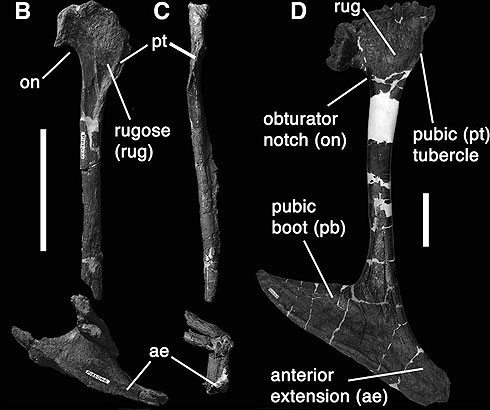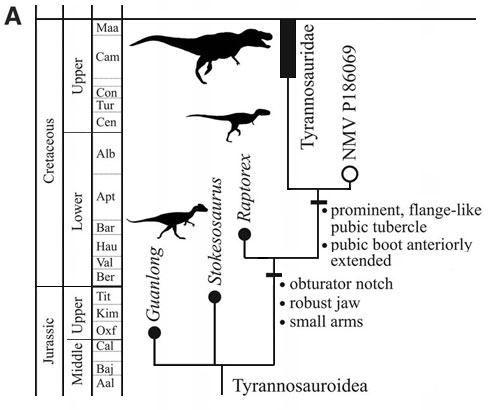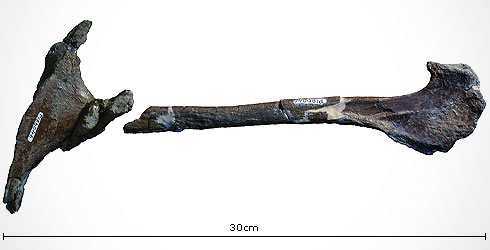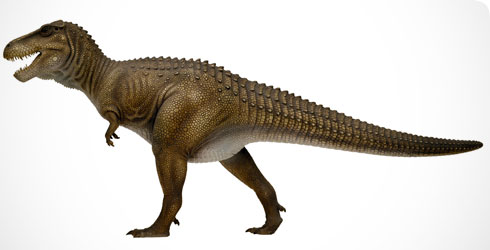Southern tyrant reptile
The southern tyrant reptile, is the first ever tyrannosauroid found in Australia or any southern continent and appears to be an ancestor of Tyrannosaurus rex.
Evidence for the southern tyrant reptile is based on the discovery and identification of a tyrannosaur (tyrannosaurid) hip bone from the late Early Cretaceous of Victoria, Australia.
'The bone is unambiguously identifiable as a tyrannosaur because these dinosaurs have very distinctive hip bones,' says Dr Roger Benson of the University of Cambridge, who identified the find.

Scientists drilling for bones in a cave in Victoria where the southern tyrant reptile hip bone was found. © Dr Tom H. Rich.
The discovery, made by a team of scientists from Cambridge University, the Natural History Museum, University of Monash, and Museum Victoria Australia, was published in Science in March 2010.
The Australian tyrannosaur, currently known as NMV P186069, was an ancestor of Tyrannosaurus rex living 40 million years earlier. The Australian ancestor was much smaller than the mighty Tyrannosaurus rex, about 3m long, weighing around 80kg .
The giant size of Tyrannosaurus rex evolved later on in the groups' evolution.
The material of this animal is currently too fragmentary to justify giving it a new species name, however it probably represents a distinct species as no other tyrannosauroids are known from this area.
Species detail
The pubis (hip) bone is almost identical to those of tyrannosaurids the family of tyrant lizards that incudes the genus Tyrannosaurus.
- pubic tubercle is broken, but the preserved portion indicates a prominent, anterolaterally curving, flangelike morphology
- The anterior expansion of the boot is substantial, as in tyrannosaurids
- The length of the pubis at 307mm is only slightly longer than the pubis of Raptorex, a member of the tyrannosaurids.
Thus, a potentially cosmopolitan grade of small tyrannosauroids with a tyrannosaurid-like body plan preceded the Late Cretaceous rise of the colossal tyrannosaurids.
-

Distribution
Find out what is known about the worldwide distribution of the tyrant lizards and why the southern tyrant reptile is such an exciting discovery.
-

Structural evidence
Find out more about the structural analysis of the 30cm-long fossilised hip (pubis) bone that led to identifying the owner as a tyrant lizard - tyrannosauroid and ancestor of Tyranosaurus rex.
-

Taxonomy
Discover more about the taxonomy of tyrannosauroids and how a surge of new discoveries is revealing diverse ecotypes and body sizes as early as the Middle to Late Jurassic
-

References
Get reference material for the southern tyrant reptile.
Images

The southern tyrant reptile is believed to be a smaller Australian ancestor of the Tyranosaurus rex shown in this illustration.

Scientists drilling for bones in a cave in Victoria where the southern tyrant reptile hip bone was found © Dr Tom H. Rich.

NMV P186046 in right lateral (B) and anterior (C) views; albertosaurine tyrannosaurid
(Royal Tyrell Museum of Palaeontology, Drumheller no. 1986.64.1) in right lateral view (D). Scale bars equal 100 mm. © Image courtesy of Science/AAAS

Distribution of Late Jurassic (bottom) and Early Cretaceous (top) tyrannosauroids © Image courtesy of Science/AAAS

Fossil remains of a relative of T. rex, part of the hip, have been discovered in Australian rocks 110 million years old. © Dr Roger Benson, University of Cambridge
About the author

Prof Paul Barrett
Dinosaur researcher and head of the Vertebrates and Anthropology Palaeobiology Division.
